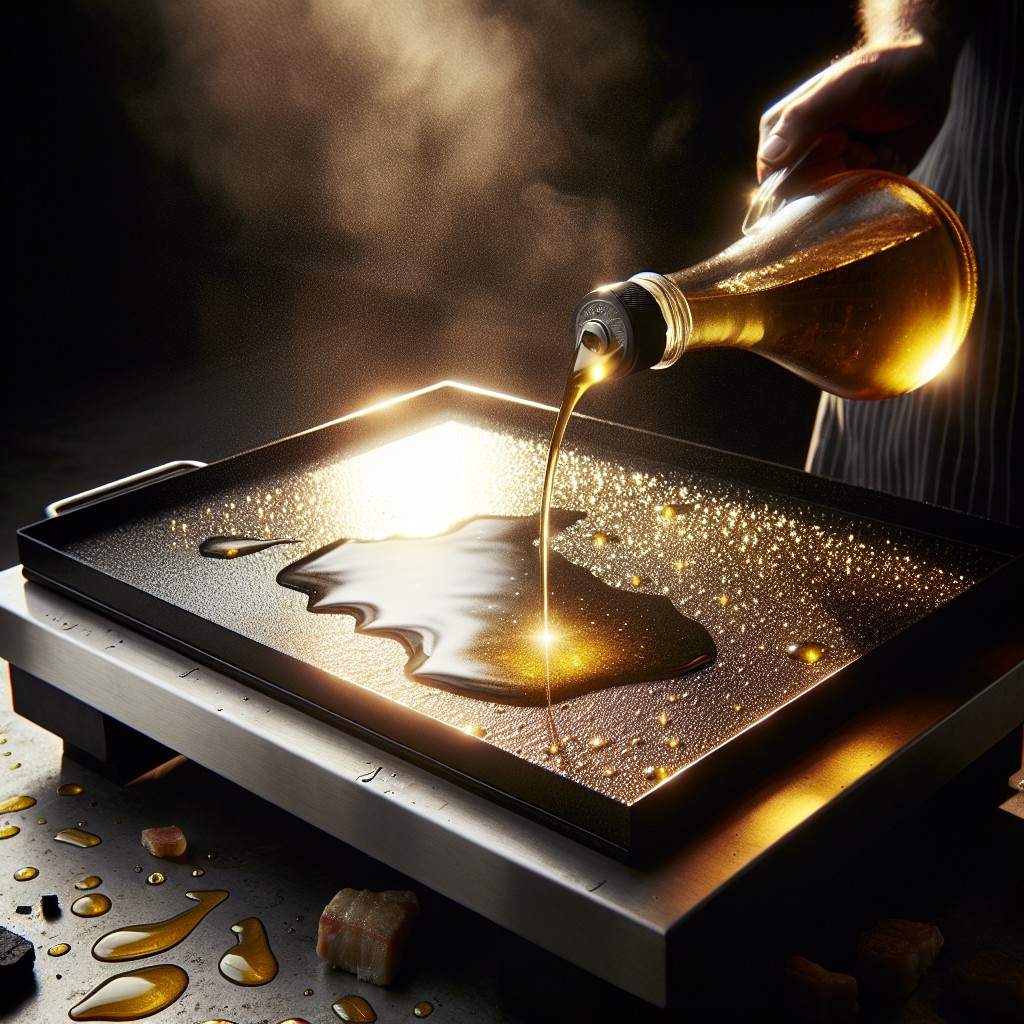Last updated on
Choosing the right oil for your Blackstone griddle is paramount because it directly influences your cooking experience and the longevity of the grill.
Key takeaways:
- Blackstone’s top recommendations: canola oil, vegetable oil, and shortening.
- Use oils with high smoke points (400-450°F) for effective seasoning.
- Avoid olive oil for high-heat seasoning due to its lower smoke point.
- Avocado oil (520°F) creates a durable, non-stick surface.
- Grapeseed oil (420°F) is versatile and offers a light flavor.
Blackstone’s Recommendation for Oils

Blackstone griddles perform optimally when seasoned with oils that have a high smoke point. This key feature allows the oil to withstand the high temperatures necessary for creating a non-stick seasoning layer without burning.
Among the brand’s top recommendations are canola oil, vegetable oil, and shortening – all known for their high smoke points and ease of application. They emphasize the benefits of these oils in creating a durable seasoning that enhances the griddle’s performance over time.
It’s the high smoke point of these oils, typically around 400-450°F (204-232°C), that ensures a polymerized coating is effectively formed. Blackstone advises against olive oil for the high-heat seasoning process due to its lower smoke point, which could lead to burning and a less effective seasoning layer.
The Importance of Oil Smoke Point

Understanding the smoke point of oil is crucial when selecting the right one for your Blackstone griddle. Here’s why:
1. Safety: Oils that are heated past their smoke point can start to smoke profusely, creating a fire hazard.
2. Flavor Preservation: Overheating oil can cause it to break down, imparting a burnt and unpleasant taste to your food.
3. Health Considerations: Beyond the smoke point, oils can release harmful free radicals and toxins that could be detrimental to your health over time.
Choosing an oil with a high smoke point ensures that you can cook at high temperatures without these concerns, keeping your griddle cooking safe, your flavors fresh, and your meals healthier.
Best Oil to Season a Blackstone Griddle
Seasoning your Blackstone griddle creates a non-stick surface and prevents rust, enhancing its performance and longevity. For best results, use oils with a high smoke point to withstand the high heat without burning.
Canola Oil: A popular choice due to its affordability and high smoke point—around 400 degrees Fahrenheit.
Avocado Oil: With a smoke point of approximately 520 degrees Fahrenheit, it’s ideal for a durable seasoning layer.
Flaxseed Oil: Though it has a lower smoke point of 225 degrees Fahrenheit, its polymerization properties create a hard, slick surface.
Grapeseed Oil: Offers a smoke point of around 420 degrees Fahrenheit and is favored for its light flavor.
Remember to apply a thin, even layer of the oil of your choice and heat the griddle according to Blackstone’s guidelines to ensure proper seasoning.
Canola Oil
Rich in monounsaturated fats and low in saturated fats, canola oil is a heart-healthy choice that pairs well with your Blackstone griddle for both cooking and seasoning.
Its smoke point of around 400 degrees Fahrenheit ensures that it can withstand the high heat necessary for griddle cooking without burning and creating unwanted flavors or harmful compounds.
This oil creates a durable, non-stick coating on your griddle surface after proper seasoning, making it a go-to option for many griddle enthusiasts.
Plus, its neutral flavor won’t interfere with the taste of your food, keeping those griddle-cooked meals tasting exactly as you intend them to.
Remember, when using canola oil for seasoning, ensure the griddle is properly pre-heated to adhere the oil to the cooking surface effectively.
The Role of High Smoke Point Oils
High smoke point oils are crucial in withstanding the intense heat required for griddle cooking without burning. When oil exceeds its smoke point, it decomposes, affects flavor negatively, and releases toxic fumes and harmful free radicals—undesirable outcomes for any culinary enthusiast.
These oils ensure a stable cooking surface, contribute to a non-stick patina, and are most effective in the seasoning process to create durable and protective layers. Including varieties like avocado, refined coconut, and almond oil, these selections maintain their structural integrity, providing optimal cooking experiences without compromising the food’s integrity or the diners’ health.
Avocado Oil
With its high smoke point of around 520°F (271°C), avocado oil is an excellent choice for your Blackstone griddle. This characteristic allows you to cook at higher temperatures without the oil smoking and breaking down, which can impart undesirable flavors to your food and potentially release harmful compounds.
As a powerhouse of monounsaturated fats, it contributes to a healthier cooking process compared to oils with higher saturated fat content.
When it comes to seasoning your griddle, avocado oil creates a durable, stick-resistant surface, thanks to its ability to polymerize and form a solid layer on the cooktop. This offers an added layer of protection for your griddle, ensuring a natural, non-stick surface that enhances with continued use.
Although it tends to be more expensive than other oils, its longevity and the minimal amount needed for effective seasoning can justify the cost in the long run. Keep in mind that the oil’s subtle, buttery flavor is a bonus, imparting a mild taste to your dishes without overpowering them.
Flaxseed Oil
Flaxseed oil is often lauded for its high omega-3 fatty acid content, but when it comes to griddle seasoning, its properties take on a different significance. With a smoke point around 225 degrees Fahrenheit, it’s relatively low compared to other oils; however, this isn’t necessarily a drawback for seasoning purposes. During the seasoning process, flaxseed oil polymerizes well, creating a durable, non-stick coating that adheres strongly to the metal surface.
Use flaxseed oil sparingly to avoid a sticky residue that can occur with heavier applications. Heat the griddle slowly to initiate the polymerization and ensure an even coating. A thin layer is all that’s required for effective seasoning, and multiple, light coats often yield the best results. It’s essential to let the griddle cool down completely between applications to build up the layers effectively.
Remember, while flaxseed oil is fantastic for creating a non-stick layer on your griddle, its low smoke point means it’s less ideal for cooking at high temperatures once the griddle is in use. Thus, consider keeping a separate, higher smoke point oil on hand for everyday cooking on your seasoned griddle.
Grapeseed Oil
Grapeseed oil stands out for its high smoke point, an impressive 420°F, making it an excellent choice for high-temperature cooking on your Blackstone griddle. This characteristic ensures that the oil won’t break down or smoke excessively during the seasoning process or while cooking, keeping your food’s flavor intact.
It’s particularly rich in polyunsaturated fats and Vitamin E, offering a nutritional boost alongside its cooking benefits. In terms of its use on the griddle, it’s known for creating a smooth, non-stick surface – an asset for flipping pancakes or searing meats with ease. It’s also relatively neutral in flavor, which means it won’t overshadow the taste of your ingredients.
Keep in mind that even though it’s efficient for seasoning, its cost can be higher compared to more common oils like canola. With grapeseed oil, a little goes a long way. Use it sparingly to maintain your griddle’s performance without unnecessary expenses.
Pros and Cons of Using Canola Oil
Canola oil is a go-to choice for many griddle owners, largely because of its affordability and wide availability. It has a relatively high smoke point of about 400 degrees Fahrenheit, which means it can withstand the heat of the griddle without burning, ideal for creating a durable non-stick surface.
On the flip side, some critics argue that canola oil isn’t the best option due to its lower smoke point compared to alternatives like avocado oil. Frequent use at high temperatures can break down the oil, potentially leaving an undesirable flavor on your griddle. Additionally, there’s controversy surrounding the health implications of consuming canola oil, as it often undergoes heavy processing.
Despite differing views, the ease of procuring canola oil and its effectiveness in seasoning makes it a widely used option. It’s also versatile for cooking a vast array of foods on the griddle. If you’re prioritizing convenience and cost-effectiveness, canola oil is an excellent choice, but for those seeking the highest quality seasoning with the most robust smoke point, you may want to explore other oils.
Pros and Cons of Using Olive Oil
Olive oil brings a rich flavor that many cooks adore, making it a tempting choice for griddle cooking. It’s also packed with healthy monounsaturated fats, which can benefit your diet. However, extra virgin olive oil has a relatively low smoke point, around 375-400°F, which can be swiftly surpassed on a hot griddle, leading to the release of unhealthy free radicals and a bitter taste as the oil breaks down.
For light sautéing or low-temperature cooking, olive oil can still be a decent option, but it’s not ideally suited for the high-heat grilling or seasoning process required for Blackstone griddles. Moreover, it doesn’t form as durable a seasoning layer compared to higher smoke point oils, meaning your nonstick surface may not be as long-lasting.
In summary, while olive oil has its culinary place, it may not be the best companion for maintaining the integrity and performance of your Blackstone griddle. Consider reserving it for dressings or dishes cooked at lower temperatures to make the most of this flavorful oil.
Griddle Seasoning With Different Oils
Seasoning your Blackstone griddle isn’t a one-oil-fits-all scenario. Different oils bring varied benefits to your griddle’s surface. Canola oil is a common go-to due to its moderate smoke point and availability. However, for a more durable seasoning, consider oils with higher smoke points like avocado oil, which can withstand higher temperatures without breaking down. Flaxseed oil, although it has a lower smoke point, is favored for creating a strong initial layer of seasoning due to its drying properties when exposed to air and heat. Grapeseed oil also makes the cut; its mild flavor and high smoke point make it a versatile choice.
Each oil will interact with your griddle’s surface differently during heating. It’s crucial to apply a thin, even layer and allow it to smoke and polymerize, hence locking in that non-stick quality. Also, be mindful that while olive oil is a kitchen staple, its lower smoke point and distinct taste might not be ideal for high-temperature grilling and long-term griddle care. Experiment with these oils to discover which yields the best results for your cooking style and maintenance routine.
How to Season a Griddle: Step-by-Step
Begin by heating your Blackstone griddle over medium-high heat, ensuring it is dry and clean. The surface will darken as it gets hotter, indicating it’s ready for seasoning.
Apply a thin layer of high smoke point oil, distributing it evenly across the surface using tongs and a cloth or paper towel. Be cautious to avoid burns from the hot griddle.
Let the oil heat until it smokes, then turn the heat down slightly. This smoke is a sign that the oil is bonding with the metal, creating a durable non-stick layer.
Once the smoking stops, let the griddle cool slightly, then repeat the process. Three to five rounds of oiling and heating will create a solid initial seasoning.
Allow the griddle to cool completely after the final round before storing it. This process prepares it for efficient and enjoyable cooking experiences.
Maintenance: Post-Seasoning Care
Maintaining your Blackstone griddle after seasoning ensures longevity and optimal cooking performance. Regular care is simple but vital. Here are a few tips:
- After each use, let the griddle cool down, then scrape off any food debris with a metal scraper or spatula.
- Wipe the surface with a cloth or paper towel to remove excess oil.
- For a deeper clean, add water to the still-warm griddle and scrub using a pumice griddle cleaner. Avoid soap, as it can strip the seasoning.
- Dry the surface thoroughly to prevent rust. If necessary, heat the griddle on low to evaporate any remaining moisture.
- Apply a thin layer of oil after cleaning and heat it briefly to maintain the non-stick surface.
- Cover the griddle when not in use to protect it from the elements.
- Inspect regularly for any signs of rust and address them immediately by re-seasoning the affected area.
By following these steps, you preserve the griddle’s functionality, ensuring many successful cookouts.
When to Re-season Your Blackstone Griddle
Recognizing the right time to re-season your griddle is key to maintaining its performance and non-stick surface. Typically, you should consider a fresh seasoning when:
- 1. The griddle’s surface starts to look dull or dry – this is a sign that the protective coating is wearing off.
- 2. You notice rust appearing, which can occur if the griddle has been exposed to moisture for an extended period.
- 3. Food starts sticking to the griddle more than usual, indicating the non-stick properties are diminishing.
- 4. After a thorough cleaning, especially if you’ve used soapy water or a degreaser, which can strip the seasoning layer off.
Seasoning isn’t a one-off task but an ongoing process. For optimal griddle performance, a light re-seasoning after every use is recommended, reinforcing the protective layer and ensuring the longevity of your cooking surface.
Safety Considerations While Using Oils On a Griddle
When applying oils to your Blackstone griddle, prioritizing safety helps prevent accidents:
- Keep a safe distance between oil bottles and the hot griddle to avoid any potential fire hazards.
- Always heat your griddle slowly to the recommended temperature before applying oil to minimize the risk of oil splattering.
- Use long-handled tongs or spatulas for oil-soaked paper towels to create a barrier between your hand and the griddle’s surface.
- Store oil containers away from direct sunlight and heat sources since heat can cause the oil to degrade or even potentially ignite if conditions are right.
- If an oil fire occurs, never use water to extinguish it. Instead, turn off the heat source if it’s safe to do so and cover the griddle with a metal lid or use a fire extinguisher designed for grease fires.
- Wear protective gear, such as heat-resistant gloves, to protect your hands and arms from any spatters or spills while seasoning or cooking.
Recap




